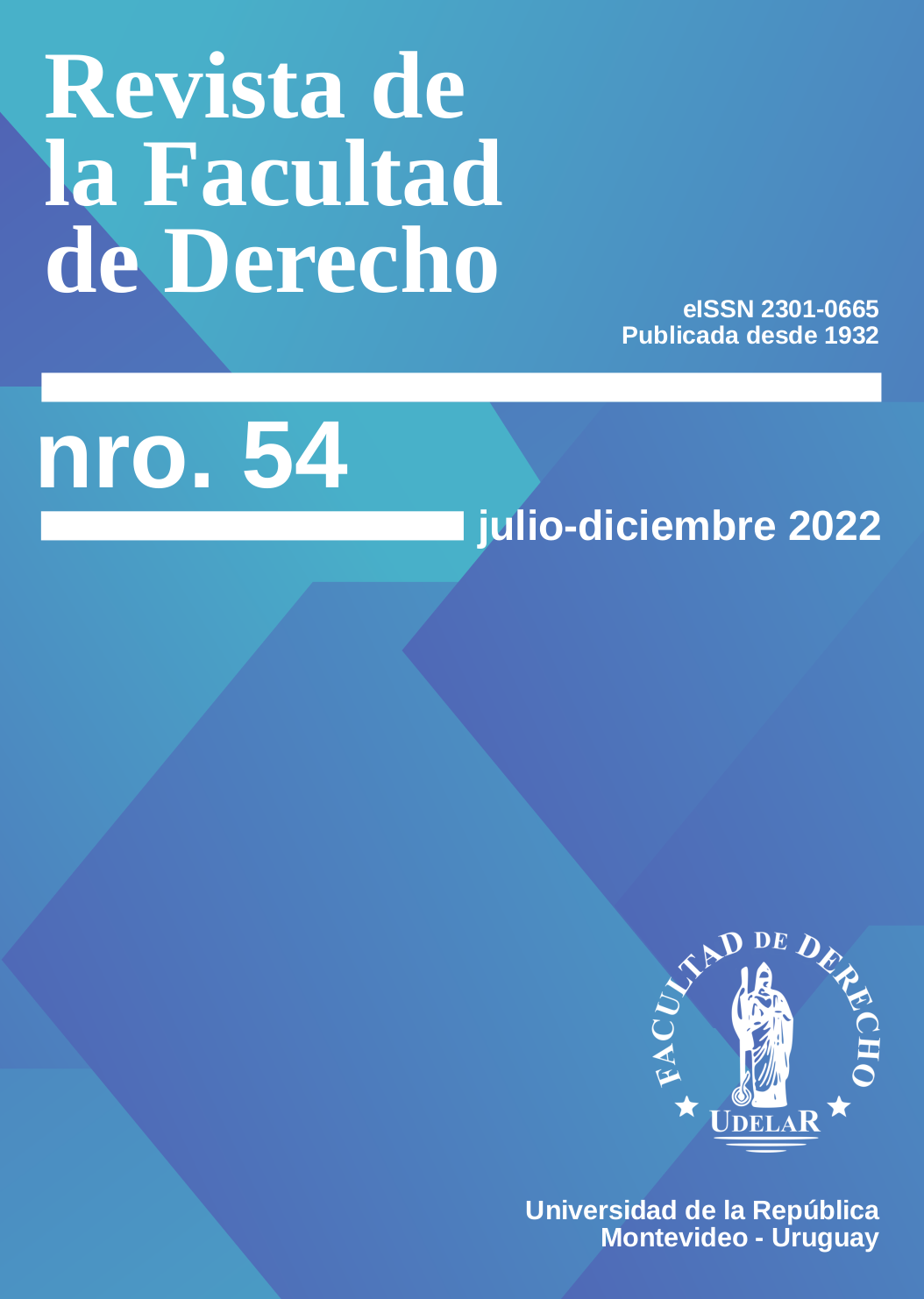Sex work, pimping and forced prostitution Where does the legal end and the prohibited begin?
Abstract
The objective of this article is to analyze the regulation of sex work and the crimes of pimping and forced prostitution, in order to determine what the law allows and prohibits in relation to the sex industry. Our country has Law 17,515 and its regulatory decree 480/003, which regulate sex work; but at the same time, it also prohibits the exercise of pimping and forced prostitution. Through this critical analysis, it will be possible to delimit the narrow line that separates the legal commercial activity of setting up and profiting from a brothel (or an establishment with similar characteristics) and the crime of pimping, for which the applicable norms will be analyzed, the doctrine and jurisprudence on the matter.
Downloads
References
Aguilar Avilés, D. (2014). El delito de proxenetismo y su regulación en el código penal cubano. Aciertos y desaciertos, Âmbito Jurídico, año XVII, 120. https://ambitojuridico.com.br/cadernos/direitopenal/eldelitodeproxenetismoysuregulacionenelcodigopenalcubanoaciertosydesaciertos/
Benítez, V. (2013). Proxenetismo Agravado. Revista pensamiento penal. http://www.pensamientopenal.com.ar/system/files/cpcomentado/cpc37812.pdf
Bayardo Bengoa, F. (1965). Derecho penal uruguayo, tomo IV JUS, Montevideo.
Cairoli, M. (2019). Derecho Penal Uruguayo. Tomo II, 3–4. La Ley Uruguay.
Camaño Rosa, A. (1967). Tratado de los delitos. Amalio M. Fernández.
Carrara, F. (1957). Programa de derecho criminal. Temis.
Cedrés, I. (2018). ¿Mi cuerpo, mi decisión?: debates y perspectivas feministas sobre la prostitución en Uruguay. UdelaR. FCSDCP.https://www.colibri.udelar.edu.uy/jspui/bitstream/20.500.12008/19038/1/TCP_CedresFerreroIsabel.pdf
Escobedo, I. (2018). La prostitución a debate. Entre el discurso médicosocial y el feminismo (1847-1875), STVDIVM. Revista de Humanidades, 23.
Guerra, P. y Gallardo, R. (2021). Feminismos y modelos prostitucionales. Apuntes sociojurídicos para el caso uruguayo. Revista latinoamericana de sociología jurídica, Año 2, (3). https://drive.google.com/file/d/1C9xadMoVkfliwUNW6MF3Lvm5_
yPvVQ5/view
Guidobono, N. y Greco, H. (2020). Diagnóstico sobre Trabajo Sexual en Montevideo. Intendencia de Montevideo.
Harcourt, C., Egger, S. y Donovan, B. (2005). Sex work and the law. Review Sexual Health, 2.
La Diaria (2022, febrero, 11). Un proyecto para modificar la ley de trabajo sexual ingresó al Parlamento. https://ladiaria.com.uy/feminismos/articulo/2022/2/unproyectoparamodificarlaleydetrabajosexualenuruguayingresoalparlamento/
Langón, M. (2017). Código Penal Uruguayo y leyes complementarias comentados. Universidad de Montevideo.
Llobet, M. (2017). ¿Prostitución?: ni sí ni no, sino todo lo contrario. Revista electrónica de Ciencia Penal y Criminología, (19). http://criminet.ugr.es/recpc/19/recpc1919.pdf
Maldonado, E. (2005). Lex Iulia de Adulteriis Coercendis del emperador Cesar Augusto (y otros delitos sexuales asociados). Anuario mexicano de historia del derecho.
Maqueda, M.L. (1988). Prostitución femenina y control: una relación controvertida. Análisis del código penal desde la perspectiva del género. Emakunde.
Maqueda, M.L. (2008). “La prostitución en el debate feminista: ¿otra vez abolicionismo?”. En Conde, M. (coord). Libro Homenaje a la Profesora Diaz Pita.
Maqueda, M. (2009). Prostitución, feminismos y Derecho penal. Comares.
Musto, C. y Trajtenberg, N. (2011). Prostitución y trabajo sexual: el estado de arte de la investigación en Uruguay. Revista de Ciencias Sociales, 24 (29), 138-156.
Musto, C. y Trajtenberg, N. (2011). Prostitución y trabajo sexual en Uruguay. UR. FCSDS. https://www.colibri.udelar.edu.uy/jspui/bitstream/20.500.12008/4593/1/DT%20S%202011%2087.pdf
Mujer y Salud en Uruguay [MYSU] (2013). Ley 17.515. Trabajo sexual. Desde la experiencia de las personas Trans. https://www.gub.uy/ministeriosaludpublica/comunicacion/publicaciones/pautasparaatencionintegralpersonasejercentrabajosexual
Naanen, B. (1991). “‘Itinerant Gold Mines’: Prostitution in the Cross River Basin of Nigeria, 1930-1950”. African Studies Review, 34 (2), 57-79.
O’Neill, M. (1997). ‘Prostitute women now’, in Scambler, G. and Scambler, A. (ed.), Rethinking Prostitution: Purchasing Sex in the 1990s. Routledge, 3–28.
Overall, C. (1992). “What’s Wrong with Prostitution? Evaluating Sex Work”. Signs 17 (4), 705-724.
Pearson, E. (2000). Human Rights and Trafficking in Person: A Handbook. Global Alliance Against Traffic in Women. http://gaatw.org/books_pdf/Human%20Rights%20and%20Trafficking%20in%20Person.pdf
Pucciarello, M. (2007). “Apuntes sobre el tratamiento jurídico de la prostitución”. En: Y. Delgado de Smith y M. C. González (Comps.), Mujeres en el mundo: historia, revoluciones, dictaduras, trabajo, religión y poesía. Lainet.
Phua, V. (2009). “The Love that Binds: Transnational Relationships in Sex Work”. Sexuality & Culture, 13, 91–110.
Real Academia Española (2021). Diccionario de la lengua española. https://dle.rae.es/
Reunión Internacional de Expertos sobre Explotación Sexual, Violencia y Prostitución (1992). “Informe Final”. The Penn State Report. State College. Pensilvania. Coalition against Trafficking in Women (abril, 1991).
Roxin, C. (2000). La Política Criminal, El Derecho Penal y el Proceso Penal". Tirant lo Blanch.
Sanders, T., O'Neill, M. y Pitcher, J. (2009). "Prostitution. Sex work, policy & politics". SAGE Publications Ltd.
Shurmann Pacheco, R.: en Reta, A. (1962). “Curso de Derecho Penal-Segundo Curso”, T. II, Centro Estudiantes de Derecho.
Shaw, I. y Butler, I. (1998). “Understanding Young People and Prostitution: A Foundation for Practice?” Br. J. Social Wk, 28.
Sobrino, C. (2018). Prostitución callejera y regulación jurídica española. Estado de la cuestión. Indret, 4, 131.
Suárez Bertora, M. (2012). Mapa de Ruta. Hacia una igualdad sustantiva. Realidades y perspectivas de la normativa vigente para la inclusión social de la diversidad sexual. MYSU.
Trochón, Y. (2003). Las mercenarias del amor: prostitución y modernidad en el Uruguay (1880-1932). Taurus.
Villacampa, C. (2020). Prohibicionismo suave para abordar el trabajo sexual callejero: ordenanzas cívicas y ley mordaza. Revista del Laboratorio Iberoamericano para el Estudio Sociohistórico de las Sexualidades, (4), art. 06, 113-130. https://doi.org/10.46661/ relies.4992
Walkowitz, J. (1993). “Sexualidades peligrosas”. En G. Duby; M. Perrot Historia de las mujeres en Occidente (T. IV). Taurus.
Waltman, M. (2011). “Prohibiting Sex Purchasing and Ending Trafficking. The Swedish Prostitution Law”. Michigan Journal of International Law, 33 (1).
Copyright (c) 2022 gestor administrador; Federico Fascioli Caorsi

This work is licensed under a Creative Commons Attribution 4.0 International License.
This journal provides open access to its content, based on the principle that providing the public with free access to research helps a greater global exchange of knowledge
Revista de la Facultad de Derecho. Creative Commons Reconocimiento 4.0 Internacional License.










